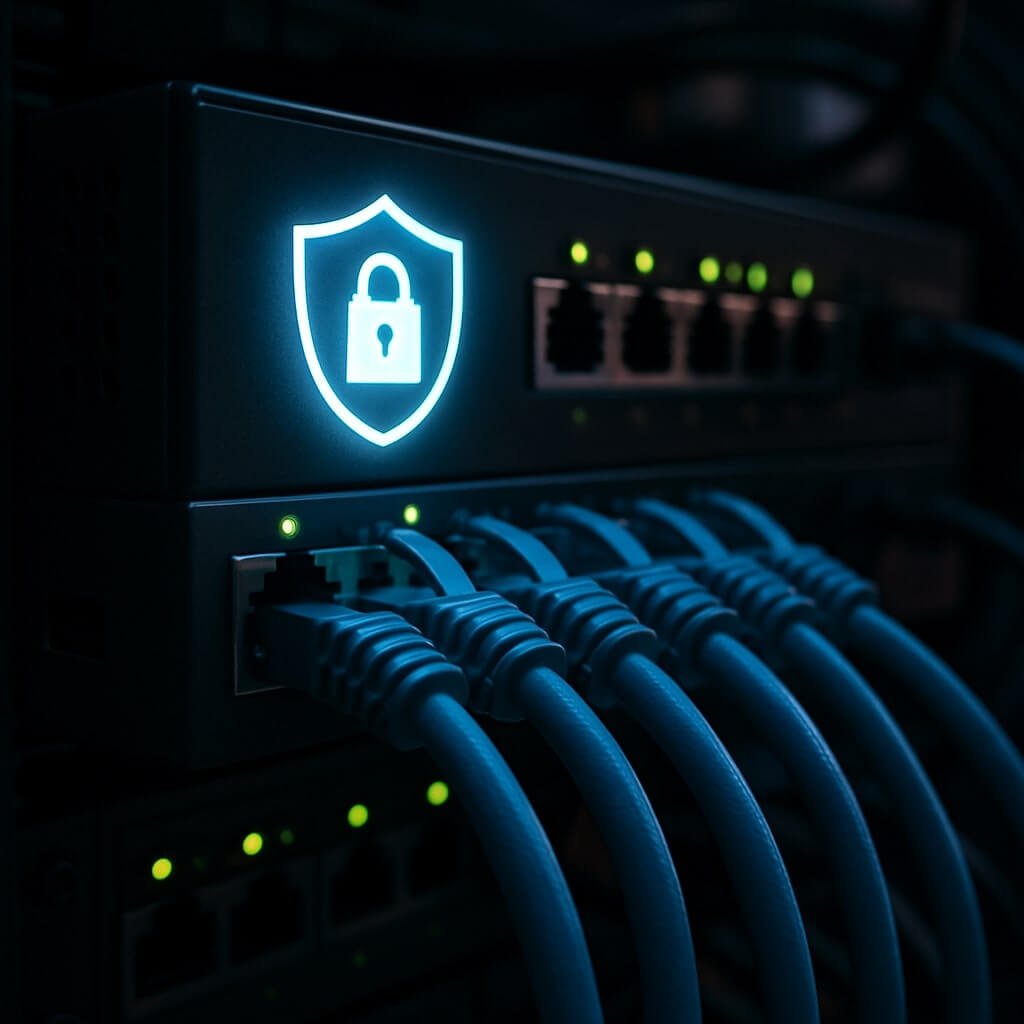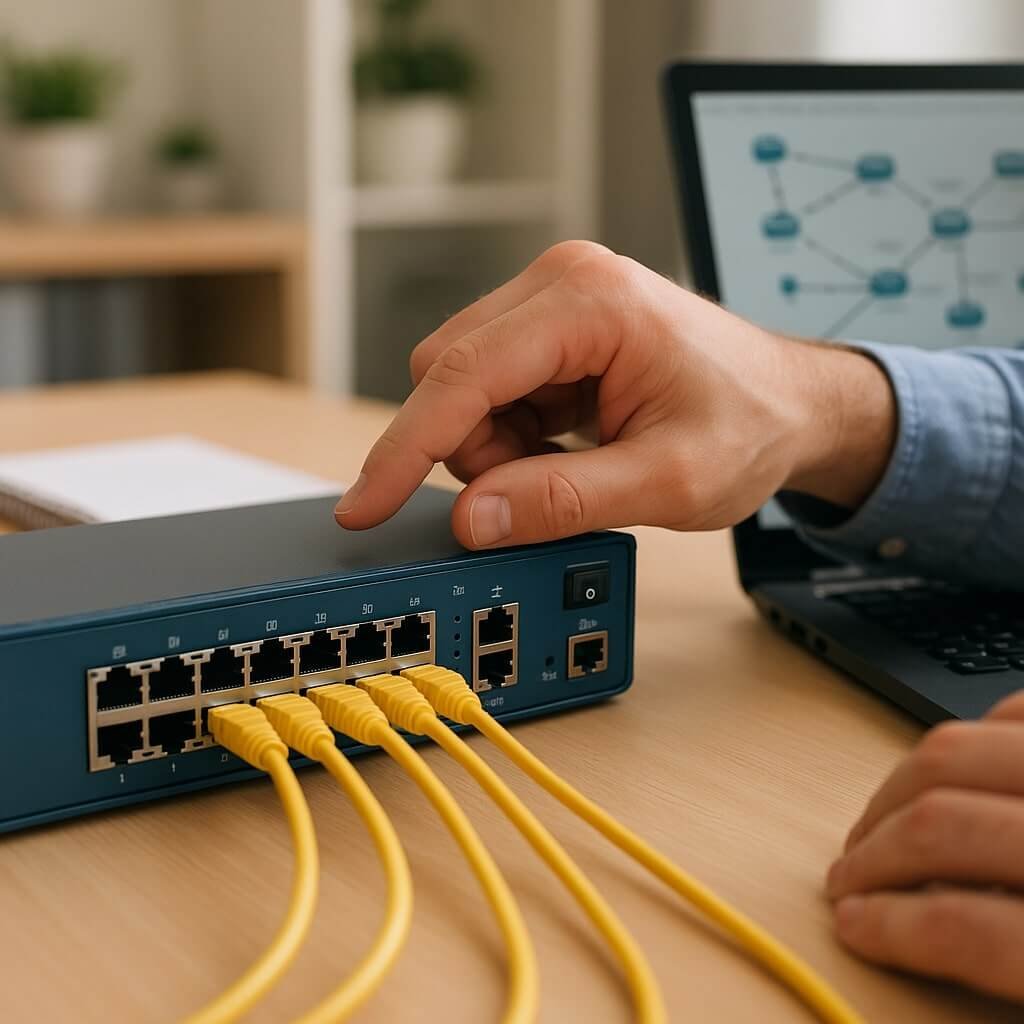Computer network security is a critical framework that safeguards your data against unauthorized access and cyber threats. It encompasses various strategies and technologies that guarantee your network’s integrity, confidentiality, and availability. As cyber threats evolve, understanding the nuances of network security becomes pivotal. You’ll want to explore its essential components and why neglecting them can lead to severe consequences for your organization. What specific measures should you focus on to fortify your defenses?
Key Takeaways
- Computer network security encompasses practices designed to protect data integrity, confidentiality, and availability from evolving threats.
- It involves risk assessment, vulnerability management, and incident response to mitigate potential security breaches.
- Key components include firewalls, encryption, and user access controls to safeguard sensitive information.
- Maintaining data integrity is crucial for reliable decision-making and preventing unauthorized manipulation of information.
- Regular updates and proactive maintenance are essential for defending against cyber threats and ensuring operational continuity.
Understanding Computer Network Security
When you explore computer network security, you’ll quickly realize that it’s more than just a collection of tools and protocols; it’s an all-encompassing framework designed to protect data integrity, confidentiality, and availability.
Understanding network security fundamentals is vital for effectively implementing cybersecurity principles. You must grasp concepts like risk assessment, vulnerability management, and incident response to build a robust defense against cyber threats. By evaluating potential risks, you can prioritize security measures tailored to your network’s unique architecture.
Additionally, continuous monitoring and updating of security protocols are essential to adapt to evolving threats. Emphasizing these fundamentals enables you to create a resilient network environment, ensuring that sensitive data remains protected while maintaining operational continuity against malicious attacks.
Key Components of Network Security
Building on the foundational understanding of computer network security, it’s important to identify the key components that form a robust security architecture.
First, you’ll need well-defined network security policies that outline acceptable use, access controls, and incident response procedures. These policies serve as a framework for protecting sensitive data and ensuring compliance with regulations.
Next, implementing technical measures such as firewalls, intrusion detection systems, and encryption enhances your defenses against unauthorized access.
Additionally, security awareness training for all employees is essential; it empowers them to recognize potential threats and adhere to security protocols.
Types of Network Security Threats
As cyber threats evolve, understanding the various types of network security threats becomes essential for maintaining a secure environment.
You need to be aware of malware attacks, which can compromise your systems, and phishing schemes designed to trick you into revealing sensitive information.
Denial attacks can disrupt services, while insider threats pose risks from within your organization.
Social engineering tactics often exploit human psychology, making you a target.
Ransomware threats can encrypt your data, demanding payment for access.
Additionally, physical security is vital to protect hardware from unauthorized access.
Be cautious of wireless vulnerabilities and zero day exploits that take advantage of unpatched software.
Finally, botnet attacks can overwhelm networks by using compromised devices, further amplifying security risks.
Importance of Data Integrity
Data integrity is essential for maintaining the accuracy of information within your network.
When you guarantee that data remains unaltered and accurate, you effectively prevent unauthorized access and potential manipulation.
This protection not only safeguards your organization’s assets but also enhances decision-making processes based on reliable data.
Ensuring Accurate Information
Maintaining data integrity is vital for any organization, as even a small breach can lead to significant consequences.
To guarantee accurate information, you must implement robust information verification processes. This involves regularly auditing data sources and validating inputs to maintain data accuracy. Using checksums and hashes can help you detect changes or corruption in your datasets.
Additionally, employing automated tools for data validation can streamline the monitoring process, reducing human error. It’s important to establish strict protocols for data entry and processing to minimize discrepancies.
Preventing Unauthorized Access
When you implement strong measures to prevent unauthorized access, you’re not just protecting sensitive information—you’re also preserving data integrity.
Effective access control is essential; it involves defining user permissions to guarantee that only authorized personnel can access specific data. Utilize robust authentication methods, such as multi-factor authentication, to bolster security.
Establish thorough security policies that guide actions and responses to potential breaches. Network segmentation can limit access to critical systems, minimizing exposure to threats.
Employ encryption techniques to safeguard data in transit and at rest. Additionally, implement monitoring systems to track unusual activities and conduct regular threat assessments, allowing you to proactively address vulnerabilities and guarantee that data remains intact and reliable.
Protecting Confidentiality in Networks
To guarantee the confidentiality of sensitive information within networks, organizations must implement robust security measures that address potential vulnerabilities.
One effective strategy is employing encryption methods, which transform data into a format that unauthorized users can’t decipher. By implementing strong encryption protocols, you ascertain that even if data is intercepted, it remains protected.
Additionally, access controls play an essential role in safeguarding confidentiality. By restricting access to sensitive information based on user roles and responsibilities, you minimize the risk of exposure. Regularly reviewing these controls and updating permissions help maintain a secure environment.
Ultimately, combining encryption methods with stringent access controls creates a layered defense, greatly enhancing the confidentiality of your networked information.
Ensuring Availability of Network Resources
While guaranteeing confidentiality is essential for protecting sensitive information, organizations must also focus on the availability of network resources to support business operations.
Effective availability management guarantees that users can access necessary data and applications without interruption. To achieve this, you should prioritize network resource allocation, strategically distributing bandwidth and processing power to meet demand.
Implementing redundancy measures, such as backup servers and failover systems, can minimize downtime during outages. Additionally, monitoring network performance in real-time allows you to identify potential bottlenecks or issues before they escalate.
Common Network Security Practices
When securing your network, implementing firewalls and intrusion detection systems is essential for monitoring and controlling incoming and outgoing traffic.
Regular software updates also play a critical role in protecting against vulnerabilities that could be exploited by attackers.
Firewalls and Intrusion Detection
Firewalls and intrusion detection systems (IDS) play essential roles in safeguarding your network from unauthorized access and potential threats. Understanding different firewall types—such as packet-filtering, stateful inspection, and application-layer firewalls—helps you choose the right protection for your needs. IDS, on the other hand, actively monitors network traffic for suspicious activity, alerting you to potential breaches.
| Firewall Type | Functionality | Use Case |
|---|---|---|
| Packet-Filtering | Blocks or allows traffic | Small networks |
| Stateful Inspection | Tracks active connections | Medium-sized enterprises |
| Application-Layer | Inspects application data | High-security environments |
| Next-Generation | Combines firewall and IDS features | Extensive security |
| Cloud-Based | Protects cloud environments | Remote work solutions |
Implementing both firewalls and IDS creates a robust security posture for your network.
Regular Software Updates
Maintaining the integrity of your network hinges on the consistent application of regular software updates. Software patches are critical for addressing vulnerabilities that cybercriminals exploit. By adhering to established update schedules, you guarantee that your systems are fortified against emerging threats.
Ignoring these updates can lead to severe consequences, including data breaches and unauthorized access, which compromise your organization’s security posture.
Implementing automated update mechanisms can streamline this process, guaranteeing timely installation without disrupting your operations. Additionally, you should regularly review your software inventory to prioritize updates based on risk assessment.
This proactive approach not only mitigates vulnerabilities but also enhances overall network performance, keeping your systems robust and compliant with security standards.
Role of Firewalls and Intrusion Detection Systems
While securing sensitive data and maintaining network integrity, firewalls and intrusion detection systems (IDS) play essential roles in modern cybersecurity strategies.
Firewalls act as a barrier between your internal network and external threats, using meticulous firewall configurations to filter incoming and outgoing traffic based on predefined security rules. This guarantees unauthorized access is effectively blocked.
On the other hand, IDS monitors network traffic for suspicious activity, providing critical intrusion detection capabilities that alert you to potential breaches in real-time.
Emerging Trends in Network Security
As cyber threats continue to evolve, organizations must adapt their security strategies to address emerging trends in network security. AI enhanced security and machine learning integration are revolutionizing threat detection, enabling automated threat detection systems to identify anomalies in real-time. Zero trust architecture is becoming essential, ensuring that no user or device is trusted by default. In addition, quantum encryption offers unprecedented data protection against potential breaches. The rise of behavioral analytics helps organizations understand user patterns, enhancing security measures. Moreover, cloud security trends and IoT security advancements are critical as more devices connect to networks.
| Trend | Description |
|---|---|
| AI Enhanced Security | Uses AI to improve threat detection and response. |
| Zero Trust Architecture | Assumes no implicit trust; verifies every access. |
| Quantum Encryption | Protects data using quantum mechanics principles. |
Best Practices for Personal Network Security
To secure your personal network effectively, you must prioritize strong password management and guarantee regular software updates.
Implementing complex passwords and utilizing password managers can markedly reduce vulnerability to unauthorized access.
Additionally, keeping your software up-to-date patches security flaws, minimizing potential attack vectors.
Strong Password Management
Creating strong passwords is a fundamental step in safeguarding your personal network security. To guarantee password complexity, use a mix of uppercase and lowercase letters, numbers, and special characters. Avoid easily guessable information, like birthdays or names. Aim for a minimum length of 12 characters; longer passwords greatly increase security.
When it comes to password storage, never write down passwords or store them in plain text. Instead, consider using a reputable password manager to securely store and generate complex passwords. This not only simplifies your login process but also enhances security.
Regularly updating your passwords and using unique passwords for different accounts reduces the risk of unauthorized access. Prioritizing strong password management is essential for protecting your digital assets.
Regular Software Updates
Strong password management lays the groundwork for robust personal network security, but it doesn’t end there.
Regular software maintenance is essential for protecting your devices from vulnerabilities. Cyber threats evolve rapidly, and outdated software can create exploitable gaps that malicious actors can target. By enabling automated updates, you guarantee your systems receive the latest security patches without delay.
This proactive approach minimizes the risk of breaches and enhances your overall defense strategy. Regularly checking for updates on all software, including applications and operating systems, further reinforces your security posture.
Conclusion
In summary, understanding computer network security is essential for safeguarding your data and maintaining operational integrity. By implementing key security components like firewalls and intrusion detection systems, you can effectively combat various threats. Prioritizing data integrity and confidentiality not only protects sensitive information but also fosters trust among stakeholders. As cyber threats evolve, staying informed about emerging trends and adhering to best practices will enhance your personal and organizational defenses, ensuring a resilient network environment.






